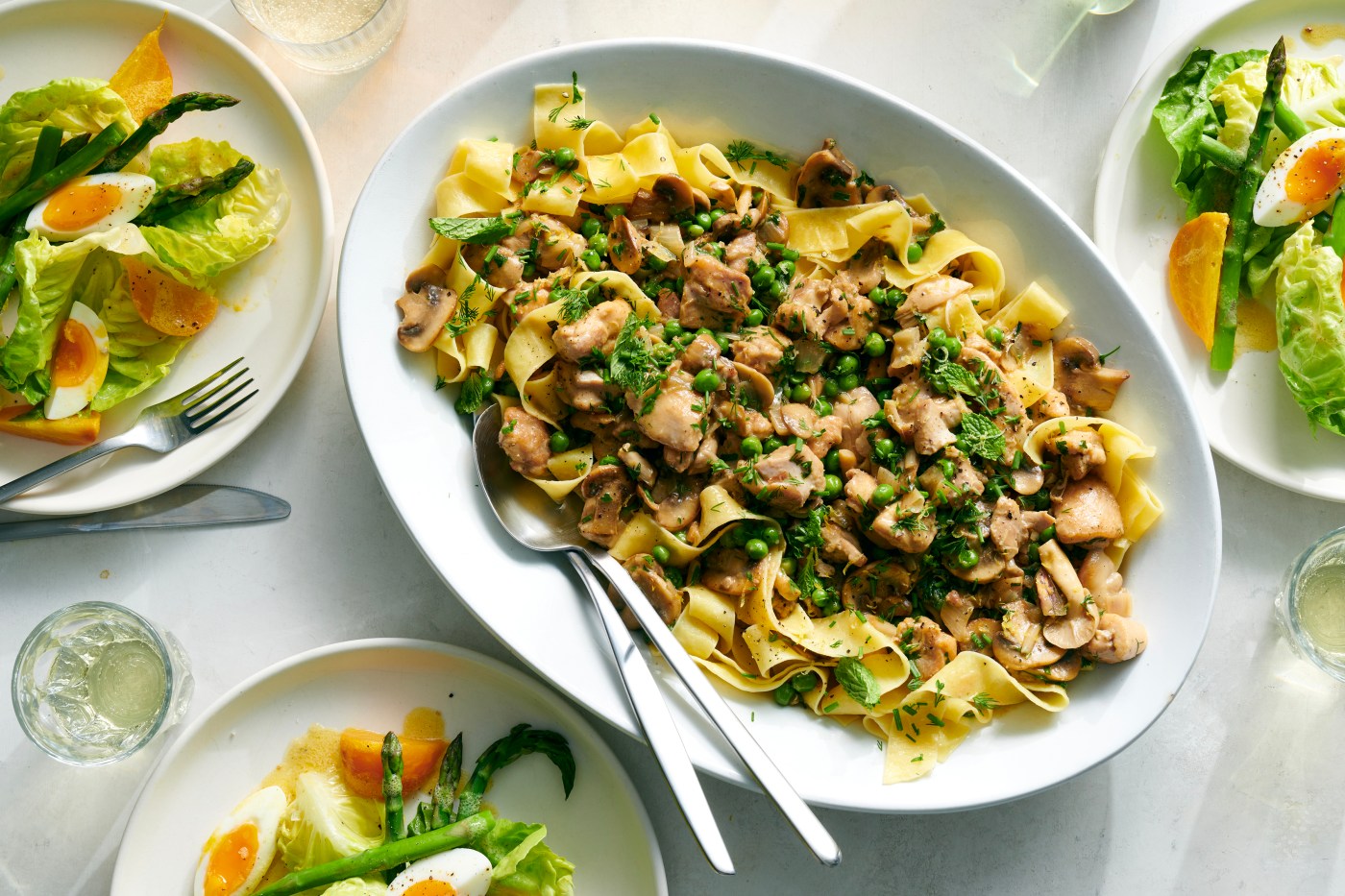
Spring fever menu: Herby chicken and noodles, asparagus salad and citrus ambrosia
The tips of deciduous trees are showing the barest tinge of green, and flowering fruit trees are in full bloom. A neighbor’s forsythia has come to life, bulbs are busily doing their thing. Spring has arrived.
At farmers markets on the West Coast, where I reside, peas and fava beans are showing up, and just last week, a few stalls were selling asparagus. Be still, my heart.
It’s a palpable thrill for an asparagus fanatic like me. The long wait is over. Let the feasting begin. Though it may be another month before the East Coast catches up, sweet spears from California are ready now.
For a first course, consider a salad to show them off. They make a pretty picture, paired with wedges of golden beets and tender butter lettuce. I love beets, but red seems wintry, somehow. Fortunately, it’s fairly easy to find bunched golden beets at most supermarkets, and they’re simple to cook (but do so a day — or several hours — in advance if you want to assemble this salad quickly).
Choose medium-thick asparagus spears, if you can, but any size is fine as long as they are shiny and smooth, with tightly closed buds.
To cook them, you need only some salted boiling water; three or four minutes should suffice. Though many recipes advise shocking asparagus spears in ice water to stop the cooking, I prefer to let them rest on a clean kitchen towel or napkin. The asparagus can easily cool to room temperature that way. Then, you just need to make a simple vinaigrette for a beautiful beginning to a meal.
For a main course, chicken-noodle anything is always an attractive option.
I used boneless, skinless chicken thighs to make a simple stew enhanced with button mushrooms and a sauce of chicken broth, white wine and a little crème fraîche. To make it sparkle, I finished it with a generous handful of herbs and lots — lots! — of lemon zest. Egg noodles, or fresh pasta, such as pappardelle, are a good choice, or serve the stew with rice if you prefer.
You can also prepare it in advance — always a good idea, to keep from being harried in the kitchen — adding the herbs and lemon zest just before serving. This chicken-noodle affair makes a satisfying, substantial main but feels light and fresh for spring.
Since we’re at the height of citrus season, a fresh fruit dessert like ambrosia seemed a good choice.
It is, however, not an “ambrosia salad,” with marshmallows, pineapple, canned mandarins and whipped topping, which has many fans. Rather, this is a simplified version of dessert-style ambrosia, the kind I grew up with.
It’s probably closer to the original 19th-century rendition, which contained only oranges and coconut, back when oranges were considered a somewhat fancy seasonal fruit. I used a few different kinds of citrus — ruby grapefruit, navel orange and blood orange. Other options would be Cara Cara oranges or Oro Blanco grapefruit.
The main thing is to let the citrus fruit sit in its juices for a while. Much like spring, it, too, is worth the wait.
Asparagus and Golden Beet Salad
Asparagus and golden beet salad. A little advance prep helps this fresh salad come together quickly. Food styled by Simon Andrews. (David Malosh/The New York Times)
The season’s first asparagus pairs with tender butter lettuce and sweet golden beets in this springy salad, which comes together quickly, with a little bit of prep. Red beets are a bit wintry for this particular dish, but fortunately, golden beets are relatively easy to find at most supermarkets and simple to cook (see Tip). Just do so a day in advance, to save yourself some time. Similarly, you can prepare the eggs a day in advance, peeling and quartering them just before serving. A little bit of savvy planning goes a long way here.
By David Tanis
Yield: 4 to 6 servings
Total time: 1 hour
INGREDIENTS
2 medium golden beets, cooked (see Tip)
2 tablespoons white wine vinegar
Salt and black pepper
1 bunch medium asparagus (about 15 spears)
2 tablespoons lemon juice
1 tablespoon Dijon mustard
1/4 cup extra-virgin olive oil
2 small heads of butter lettuce, leaves separated, rinsed and patted dry
2 to 3 soft-boiled eggs, peeled and quartered (optional; see Tip)
DIRECTIONS
Cut beets into smaller wedges or slices, and transfer to a salad bowl. Sprinkle with 1 tablespoon vinegar. Season with salt and pepper.
Snap off tough ends of asparagus. In a medium pot, bring abundantly salted water to a low boil and cook asparagus for 3 to 4 minutes, until just tender. Remove and spread out on a kitchen towel to cool. Set aside.
Make the vinaigrette: Put the remaining 1 tablespoon vinegar and all of the lemon juice in a small bowl. Add mustard and whisk to dissolve. Slowly whisk in olive oil. Season to taste with salt and pepper.
Add salad leaves to beets and dress very lightly with about 1 tablespoon of the vinaigrette.
Arrange leaves and beets on a platter or individual plates. Top with asparagus and a half egg, if using, per plate. Drizzle remaining dressing over everything and serve.
Tips: To prepare the beets, peel and quarter them. Add to a medium pot over medium-high heat, add water to cover and salt abundantly. Simmer until easily pierced with a fork, 25 to 45 minutes, depending on the size of the beets. Cool. (You can make the beets in advance and refrigerate for up to 2 days.)
For soft-boiled eggs, lower large eggs into rapidly boiling water; when water returns to boil, lower heat to a brisk simmer; cook 7 minutes, then cool in ice water and peel.
Spring Chicken With Mushroom and Lemon
Spring chicken with mushroom and lemon. Egg noodles or fresh pasta are an ideal accompaniment for this cozy dinner. Food styled by Simon Andrews. (David Malosh/The New York Times)
For a main course, chicken-noodle anything is always an attractive option, and here, boneless, skinless chicken thighs come together with button mushrooms and a sauce of chicken broth, white wine and crème fraîche for a bright, filling stew. To make it sparkle, it’s all finished with a generous handful of tender sweet herbs and lots of lemon zest. Egg noodles, or fresh pasta, such as pappardelle, are a good choice.
By David Tanis
Yield: 4 to 6 servings
Total time: 1 1/2 hours
INGREDIENTS
4 tablespoons unsalted butter or extra-virgin olive oil, plus more as needed
1 pound button mushrooms, or a mix of other mushrooms, sliced
Salt and black pepper
1 1/2 pounds boneless, skinless chicken thighs, cut into 1/2-inch pieces
2 tablespoons all-purpose flour, for dusting
2 large shallots, diced
1 small bay leaf
1/2 cup dry white wine or vermouth
2 cups chicken broth
12 ounces wide egg noodles or wide-cut pasta, for serving
1/4 cup crème fraîche
1 cup frozen peas (optional)
2 tablespoons snipped chives
2 tablespoons roughly chopped dill
1 tablespoon roughly chopped tarragon
1 tablespoon roughly chopped mint
3 tablespoons roughly chopped chervil or parsley
Zest of 2 lemons (about 2 tablespoons)
DIRECTIONS
Put 2 tablespoons butter in a Dutch oven or deep, wide skillet over medium-high heat. When butter sizzles, add mushrooms, season with salt and pepper, and cook, stirring, until mushrooms are lightly browned and softened, 3 to 4 minutes. Turn off heat. Transfer mushrooms to a plate, and set aside.
Season chicken with salt and pepper. Dust lightly with flour; shake off excess. Add the remaining 2 tablespoons butter to the same Dutch oven and turn heat to medium. When butter sizzles, add half of the chicken, letting it brown on all sides, about 5 minutes per batch. Remove from the pot. Add remaining chicken and repeat, setting aside the chicken. (You may have to add more butter or oil.)
Add shallots to the Dutch oven, and cook over medium-high heat until softened, about 2 minutes. Add bay leaf and wine, and simmer for about 2 minutes, scraping the pot to deglaze any browned bits. Return chicken to pot and turn heat to high.
Add chicken broth and bring to a boil. Turn down heat to maintain a brisk simmer and cook, uncovered, until the chicken is tender, about 20 minutes, then raise heat to high and let liquid reduce by half, about 5 minutes.
Meanwhile, cook noodles or pasta in salted water.
Add reserved mushrooms, crème fraîche and peas, if using, to the stew. Reduce sauce again, until thickened to a gravylike consistency, a few minutes more. Taste and adjust seasoning. To finish, stir in half of the chives, dill, tarragon, mint, chervil and lemon zest, reserving part of the herb mix to sprinkle over top.
Drain noodles or pasta, transfer to a warm serving platter and spoon chicken and sauce on top, and finish with more of the herb mixture.
Citrus and Coconut Ambrosia
Citrus and coconut ambrosia. Made with a mix of citrus (grapefruit, navel and blood oranges), this light, refreshing dessert gets better with time. Food styled by Simon Andrews. (David Malosh/The New York Times)
Many know the kind of ambrosia with marshmallows and whipped topping, called ambrosia salad. This, on the other hand, is an elegant, simplified (and perhaps closer to the 19th-century original) version of dessert-style ambrosia. It can and should be prepared up to several hours before serving. The main thing is to let the citrus fruit sit in its juices for a while. It’s worth the wait.
By David Tanis
Yield: 6 servings
Total time: 40 minutes
INGREDIENTS
2 small grapefruit
2 large navel oranges
4 blood oranges
1/4 cup orange liqueur
1 tablespoon orange marmalade
1/2 cup shredded unsweetened coconut
2 tablespoons sugar
DIRECTIONS
Heat oven to 375 degrees. Cut off tops and bottoms of grapefruit and oranges so they’ll sit on a cutting board without wobbling. With a sharp knife, remove the peel and pith from each fruit.
Holding each grapefruit and navel orange over a serving bowl, use a small sharp knife to cut between membranes to remove segments from the fruits. Using your hands, squeeze any juice from the citrus remains over the segments. Discard the remains. Cut blood oranges crosswise into thin slices and add to bowl.
Stir together orange liqueur and marmalade, and add to the bowl. Gently mix fruit, cover and refrigerate until ready to serve, at least 30 minutes.
Meanwhile, make the coconut topping: In a small ovenproof skillet or baking pan, spread coconut and sugar in a thin layer. Toast the mixture for a few minutes in the oven until lightly browned and fragrant. (Alternatively, you can toast in a 375-degree toaster oven.) Remove and cool. (You can also do this in advance.)
Serve ambrosia in small bowls or wide goblets, with coconut mixture sprinkled on top at the last minute.
Related Articles
Passover recipe: Turmeric Vegetable Matzo Ball Soup
Passover Recipe: Cast-Iron Potato and Caramelized Onion Kugel
Quick Fix: Stacked Goat Cheese Quesadillas with Avocado Lettuce Salad
Crepes with asparagus, ricotta and lemon give the taste of spring
A quick skillet turkey dinner you’ll make over and over again


